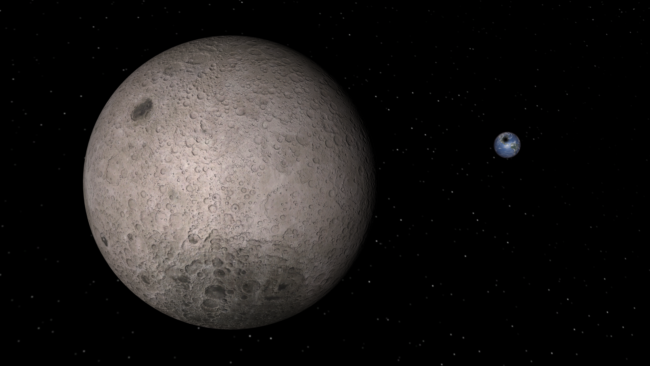Archive for year 2017
Scales & Scholars | Update 20.4
Dec 21st
Run Steam to download Update 20.4, or buy Universe Sandbox ² via our website or the Steam Store.
Update 20.4 features five new simulations:
- Check out our Solar System in its current state in real time
- Cram all of the planets between the Earth and Moon (see clip above)
- See the asteroid Apophis’s close call with our planet in 2029
- Spend some time with Earth’s companion, 2016 HO3
- Explore the scale of the planets in our Solar System
This update also features tons of new descriptions so you can learn more about the astronomy, physics, and history of the simulations. There is also a new texture for the minor planet Vesta.
Check out the full list of What’s New in Update 20.4.
We are still hard at work on our next big release, Update 21. Stay tuned after the New Year for more information.
Happy Holidays!
Oculus Store Launch | Update 20.3.1
Dec 7th
Universe Sandbox ² is now officially available on the Oculus Store!
And to celebrate, we are 15% off: Universe Sandbox ² on Oculus Store
If you’re a Rift user already, you should see some big performance boosts in VR, thanks to the added support for the Oculus technology in this update. Oculus technology features their Asynchronous Spacewarp, which helps keep the visuals and tracking feeling smooth, even when there’s a dip in performance.
This update also includes a number of smaller improvements and bug fixes. Check out the full list of What’s New in Update 20.3.1.
Special thanks to our VR developer, Jacob, for making all of this possible!
Follow @universesandbox
A New Exoplanet & Interstellar Messenger | Update 20.3
Nov 21st
Run Steam to download Update 20.3, or buy Universe Sandbox ² via our website or the Steam Store.
Update 20.3 features two new simulations for the recently discovered exoplanet, Ross 128 b, and the first observed interstellar visitor, ‘Oumuamua. This update also includes a number of smaller improvements and bug fixes.
Ross 128 b
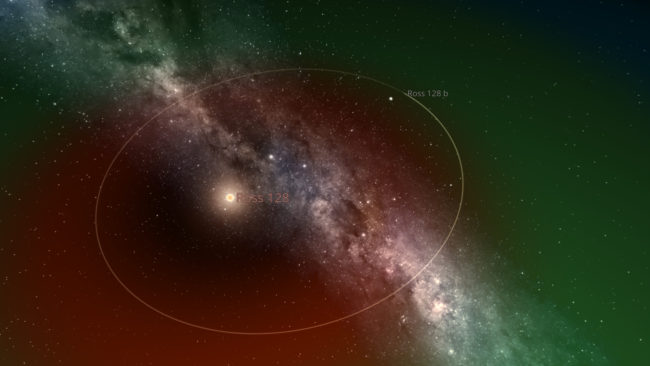
On November 15, 2017 astronomers with the European Southern Observatory (ESO) discovered Ross 128 b, a potentially habitable, Earth-sized exoplanet orbiting a red dwarf star 11 light years away.
Though Ross 128 b is farther than the closest temperate planet, Proxima b, it orbits a “quieter” red dwarf that emits far less deadly ultraviolet and X-ray radiation. This makes it a much better candidate for habitability.
See Ross 128 b in Universe Sandbox ²:
Home > Open > Ross 128 with Earth-sized Planet
‘Oumuamua
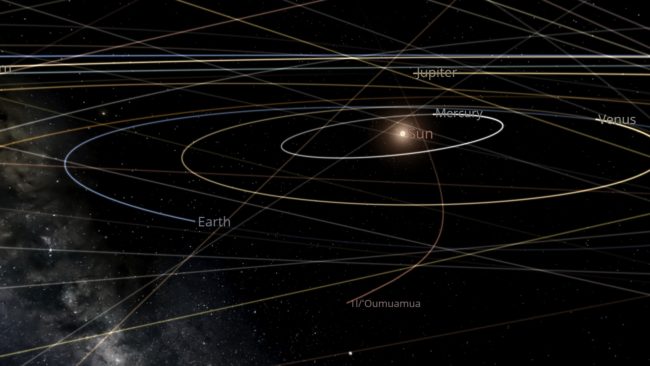
On October 19, 2017, astronomers in Hawaii observed an asteroid soaring past Earth. Analysis of its trajectory revealed that it is the first interstellar object ever observed in our solar system. Nicknamed ‘Oumuamua, meaning “a messenger from afar arriving first,” the asteroid carries the story of a distant star system born a long time ago.
Learn more about ‘Oumuamua on NASA’s website.
See ‘Oumuamua in Universe Sandbox ²:
Home > Open > Oumuamua in 2017
Check out the full list of What’s New in Update 20.3.
The New Dynamic Bottom Bar
Nov 17th
We improved the bottom bar of the user interface in our last few updates. Now when you change the width of the Universe Sandbox ² application window, the bar automagically resizes. Buttons that don’t fit are grouped into a More button, and if the window is narrow enough, the bar adapts to two rows. (Please note that this design is a work in progress and likely to change in future versions.)
It’s a small touch, and you may not think it’s that useful at first, as you probably won’t be resizing your window too often. But the portrait-style ratio of the window at the end of the video above may look familiar, and that’s because it’s very similar to your smartphone.
This dynamic resizing tech is extremely useful for Universe Sandbox ² on mobile devices. Use it in portrait mode or flip your phone sideways and use it in landscape — everything shifts and resizes seamlessly.
Thanks to our mobile developer, Dave, for all of his great work on Universe Sandbox ²!
Sign up to be notified when Universe Sandbox ² is available on mobile!
Universe Sandbox ² Featured in Vsauce Video
Nov 2nd
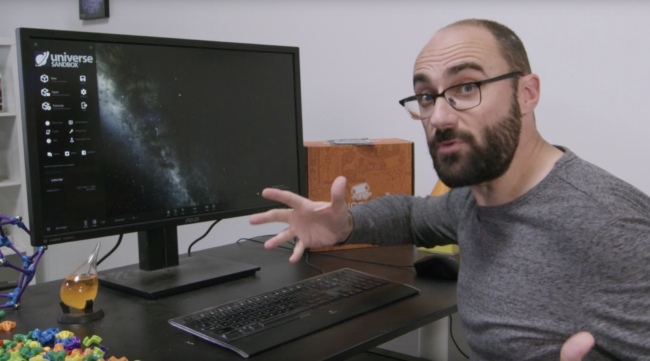
Friday, November 3rd: We’ve released Updates 20.2.3 and 20.2.4, which add two sims from this Vsauce video as well as a few improvements and bug fixes. See the sims in Home > Open.
Hey, did you hear that? Michael from Vsauce just gave some high praise of Universe Sandbox ²: “This simulator will blow your mind. I love it.”
Vsauce is a science and education YouTube channel that has attracted over 12.5 million subscribers with “videos that feed the curious and illuminate the amazing.”
We’re very honored and humbled to be featured in their latest video! Check it out below.
For the latest Universe Sandbox ² news, follow us on Twitter and Facebook.
See Asteroid 2012 TC4’s Trip Past Earth
Oct 13th
On October 12, 2017, asteroid 2012 TC4 passed Earth early in the morning, flying above Antarctica at around 1:42am EDT.
See its close approach in Universe Sandbox ²:
Home > Open > Historical > 2012 TC4 Passes Earth on October 12, 2017
The roughly house-sized asteroid passed just a bit beyond the orbits of communications satellites, well within the Moon’s orbit. This wasn’t close enough to pose any threat, but its orbit was slightly changed by Earth’s gravity, as you can see in the GIF above from Universe Sandbox ². Learn more on NASA’s website
For the latest Universe Sandbox ² news, follow us on Twitter and Facebook.
Cassini’s Limitations in Universe Sandbox ²
Sep 28th
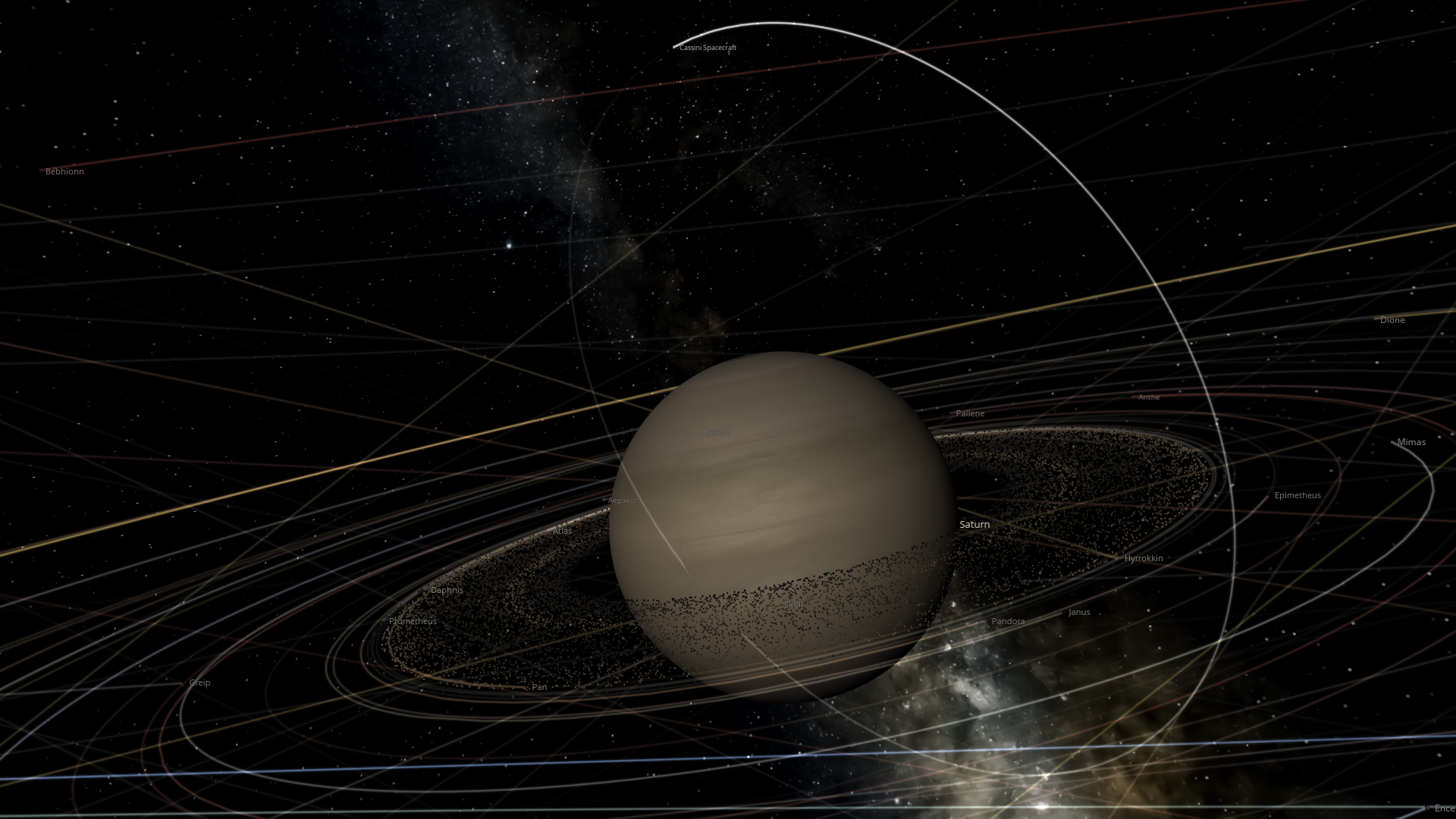
It’s been two weeks now since we said goodbye to the Cassini spacecraft. After its 20-year-long mission in space, it was running low on fuel, so NASA directed it toward Saturn in order to eliminate the risk of it contaminating the moons. On September 15, 2017, Cassini sent its final image back to Earth before disintegrating in Saturn’s atmosphere.
To commemorate this event, we released Ciao, Cassini | Update 20.2 which featured a simulation of Cassini’s final hours and collision with Saturn.
See Cassini’s final hours in Universe Sandbox ²:
Home > Open > Core/Historical > Cassini collision with Saturn on September 15, 2017
Home > Tutorials > Science > What Is Cassini’s Grand Finale?
Simulation Limitations
We had initially been wary of including a simulation of this event, as there are several limitations in Universe Sandbox ² that reduce the realism of this particular simulation. In the end, however, we decided it was still an informative and interesting visualization of an event that is very important to science and the world.
But instead of brushing these limitations under the rug, we’d like to take a closer look at them.
1 – Atmospheric Entry
We love collisions in Universe Sandbox ². But just because an object is on a collision course with a planet, that doesn’t mean it should actually collide with that planet in every scenario. If it’s small enough, then it should instead disintegrate in the planet’s atmosphere. This is what happened to Cassini as it entered Saturn’s atmosphere.
Universe Sandbox ² doesn’t yet simulate the forces associated with atmospheric entry, like atmospheric drag and aerodynamic heating. So instead, small objects will simply collide with planets. We’re very interested in simulating these effects in Universe Sandbox ², not just for objects like Cassini, but also for meteoroids that should burn up in an atmosphere, creating meteors or “shooting stars.”

An animation from Wikipedia of a meteoroid losing material as it enters Earth’s atmosphere
2 – Rocket Engines & Spacecraft Flight
Cassini didn’t stay in orbit around Saturn for 13 years, weaving through its rings and doing close flybys of its moons, all by the grace of gravity. No, its trajectory was carefully planned by engineers and frequently adjusted with its rocket engines. But while Universe Sandbox ² has models of various spacecraft, it doesn’t yet include any way to simulate or control propellant. You can manually change an object’s velocity, but you can’t apply a force to it in the same way that a rocket engine would.
We’re still a while away from controlling thrust on spacecraft and flying them through simulations in Universe Sandbox ², but we’re taking steps in that direction with our work on rigid body physics. This new tech will better simulate the physics of smaller-scale objects, such as spacecraft, allowing for precise collisions and parts that can be attached with breakable joints and other constraints.
3 – Minimum Size for Impact Visuals
When the Shoemaker–Levy 9 fragments collided with Jupiter, observers from Earth could see marks on Jupiter that were more easily visible than the famous Great Red Spot. Some of these fragments were larger than one kilometer in diameter. The Cassini spacecraft, on the other hand, was only about 6.8 meters high and 4 meters wide. Its disintegration in Saturn’s atmosphere should not be easily visible, and even if it were to collide with Saturn instead of disintegrating, it should not leave a large impact mark. [Our Cassini update added a quick fix for this problem to disable an impact mark for its collision.]
Unfortunately, in Universe Sandbox ², impact marks have a minimum visual size. This minimum size is much larger than it should be for small asteroids and human-sized objects. The alternative is to not show any impact mark at all, but that can also be unsatisfactory. There are technical reasons for this limitation, but let’s not worry about those, because there’s good news…
We are currently working on a new system which will allow for impact marks and craters of any size, no more minimum. And on top of that, the new system will be a lot faster, too, and scale to the system resolution, which should help lower-end hardware a lot.
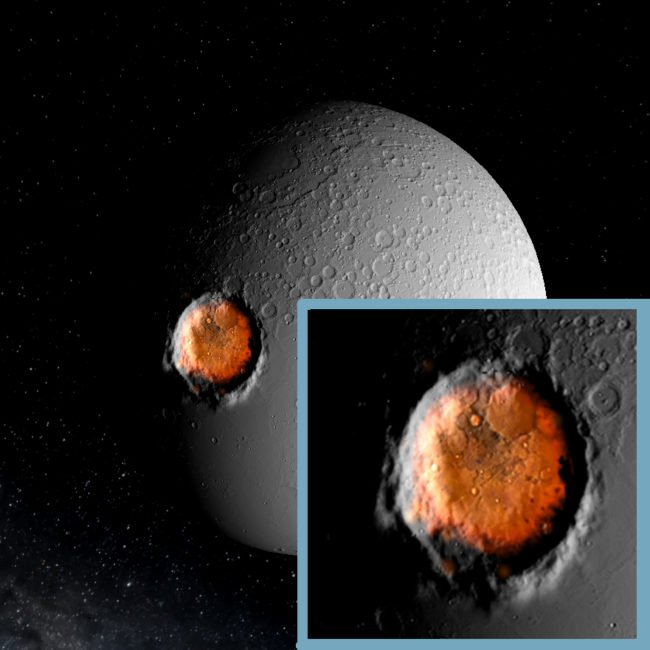
Work-in-progress screenshot of the new impact visuals in Universe Sandbox ²/span>
Opportunities, Not Limitations
The first rule of self-criticism (which we didn’t follow above) is that it’s necessary to throw things in a positive light. Drawbacks, weaknesses, limitations — they’re all opportunities for improvement! Often times these simulations of historical events are great tests of the simulation. When we put in the known properties and velocities for a set of bodies, does the simulation play out similarly to how it did in observed reality? If something is different, how can we improve the simulation in order to achieve the same results? But if instead it’s remarkably similar, as it sometimes is, then we can give ourselves a nice pat on the back and sit back and relax… Until we load a different simulation and notice another opportunity for improvement. We often say that building a universe simulator is never a completed job. A big chunk of that lies within our commitment to continuously notice where we can improve, and then take the necessary steps to make these improvements.
The above items are all on our to-do list, though we can’t promise when they will be added to Universe Sandbox ². Learn more about what we’re working on in our 2017 Roadmap.
For the latest Universe Sandbox ² news, follow us on Twitter and Facebook.
Ciao, Cassini | Update 20.2
Sep 14th

Run Steam to download Update 20.2, or buy Universe Sandbox ² via our website or the Steam Store.
November 3: Updates 20.2.3 and 20.2.4 are small updates which add two sims from the latest Vsauce video as well as a few improvements and bug fixes.
November 2: Update 20.2.2 is a minor update which includes a number of improvements and bug fixes.
October 5: Update 20.2.1 a minor update which adds a Cassini spacecraft model, Quicksave & Quickload (F5 & F9), and a number of smaller improvements and fixes.
On September 15, 2017, the world says goodbye to the Cassini spacecraft as it ends its historic mission with a final plunge into Saturn.
During its 13 years orbiting Saturn, Cassini made a number of invaluable discoveries about the planet, its rings, and its moons.
We now know that massive geysers covering the south polar region of the moon Enceladus shoot icy particles into space, forming most of Saturn’s E-ring and hinting at a massive, subsurface ocean. And we now know that the surface of Titan, Saturn’s biggest moon, shares a surprising number of characteristics with Earth, including dunes, mountain ranges, rivers, lakes, and seas.
With its array of sophisticated instruments, Cassini watched as storms raged on Saturn and seasons changed. It discovered eight new moons, provided insight into the behavior of its famous rings, and completely changed our understanding of its magnetosphere. The mission has been extended twice and now Cassini has been in orbit nine years longer than originally intended. Its fuel is nearly gone and so, to prevent possible contamination of any of the moons, its course has intentionally been set for disintegration in Saturn’s atmosphere.
So now we say ciao, Cassini. Thanks for all of your work.
And thanks to all of the hard-working scientists from NASA, the European Space Agency, and the Italian Space Agency who made the Cassini mission possible.
See Cassini’s final hours in Universe Sandbox ²
Home > Open > Core/Historical > Cassini collision with Saturn on September 15, 2017
Home > Tutorials > Science > What Is Cassini’s Grand Finale?
This update also includes a number of smaller improvements and bug fixes.
Check out the full list of What’s New.
For the latest Universe Sandbox ² news, follow us on Twitter and Facebook.
Universe Sandbox ² Updated 2017 Roadmap
Aug 28th
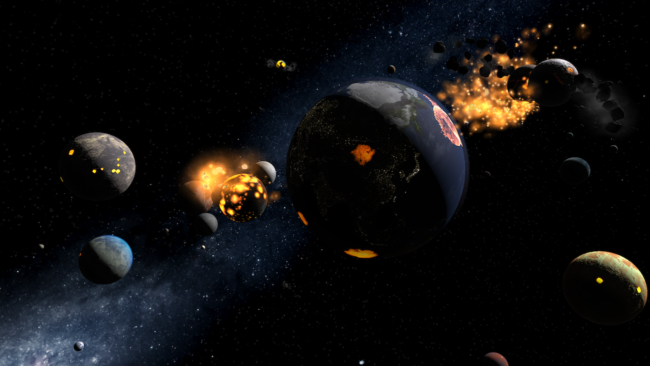
What’s Completed
At the beginning of this year, we shared Part I and Part II of our roadmap for 2017. We’ve now well past the halfway point, so it’s time for an update on what we’ve accomplished so far and we’ve got our sights set on for the rest of 2017 and into next year.
A New Foundation & VR 2.0 | Update 20
This was a big update for us, with a lot of important behind-the-scenes changes and a big list of VR improvements. Below are some of the highlights from this update; check out the Update 20 post for more information on how it’s paving the way for some bigger changes down the road.
- Rewritten, Scalable User Interface
- With our rewritten user interface, you can now scale the interface for smaller and larger resolutions.
- Future support for on-the-fly switching between multiple languages (see below).
- New Code Architecture
- A major reorganization that will make it easier for us to maintain our code, track down bugs, and develop and iterate on features.
- VR added Disintegration, Teleportation, and a Lot More
- Added all the new simulation features, improvements, and fixes from the Disintegration desktop updates, including…
- Tidal forces
- Improved explosions, and…
- New fragment and particle system
- A completely rewritten locomotion system for more responsive and smoother panning, scaling, and the all new rotation
- Teleportation! It’s never been easier to move from one planet to another
- Added all the new simulation features, improvements, and fixes from the Disintegration desktop updates, including…
Update 20 also included a long list of smaller improvements and bug fixes. And in the past couple of months since its release, we’ve pushed out smaller patches with many more bug fixes, plus the eclipse update below.
Solar Eclipse | Update 20.1
You probably heard about the August 21 solar eclipse that was visible from all of North America. We hope you were able to see it in person! But if you weren’t able to, or if you just want to see it over and over again now, then we’ve got just the simulation for you. See the Update 20.1 blog post for more info.
- August 21, 2017 Total Solar Eclipse Simulation
- Home > Open > Total Solar Eclipse on August 21, 2017
- A simulation of the Moon passing between the Sun and Earth and blocking out light across North America.
- Shadow Improvements
- Using past eclipse images as a guide, we’ve tweaked shadows just a bit to better capture Moon’s shadow on Earth.
- Advance Time Feature
- Introduced in 20.1.1, this feature allows you to run the sim until a specified length of time has passed. Just click the timer in the bottom bar to set a date or length of time then click Start!
What’s Coming Next
The following list is in a very rough order. These are all things we are working on currently, but when they’ll arrive is difficult to predict. If we had to guess when we’ll first start seeing them, we’d have to simply say “soon.”
Planet Grids
A debugging tool we are using to test the new planet grids. This tool shows how temperature is broken down into data points across the surface of the planet.
Planet Grids (previously called “automata”) is a new piece of tech that we’ve been working on for a while now that we’re very excited to introduce. The first stage of this tech allows us to simulate localized temperatures across surfaces, rather than an average temperature for the whole object. In turn, this will allow for much more dynamic and detailed visuals and simulation. This is also a crucial first step for another feature that’s long been coming…
Lasers
Lasers are fun for everyone! We’re very excited about introducing these, but it’s possible the community is even more excited. We don’t blame you. Good news: the laser is coming soon to the desktop version and will simultaneously return to VR with improved realism and functionality.
- From Laser Pointer to Planet Destroyer
- Set the power of the laser to go from a realistically-powered laser pointer to a laser far more powerful than anything ever produced, one capable of melting all of the ice off of Earth and heating it up to the point of complete vaporization.
Stellar Evolution
We unfortunately had to push this out of the Update 20 release because it simply took longer than expected and was not finished. The model itself is complete, but removing the old model and replacing it with the new is no simple task. Once we’ve got it plugged in, we’ll need to thoroughly test it to make sure that everything is in good shape and working as expected. This also is no simple task (there are many variables when it comes to testing stellar evolution in a universe simulator), but we’re definitely nearing completion.
- A Rewritten Model for the Life of a Star
- The new model supports 16 evolutionary star types versus the previous 5. It is primarily a function of mass and age or metallicity, and will work for evolutionary types outside of main-sequence stars.
- The results will be more dynamic and accurate properties for stars, as well as smoother transitions from type to type. It will also support mass loss from solar winds, and be able to differentiate envelope from core.
Steam Workshop
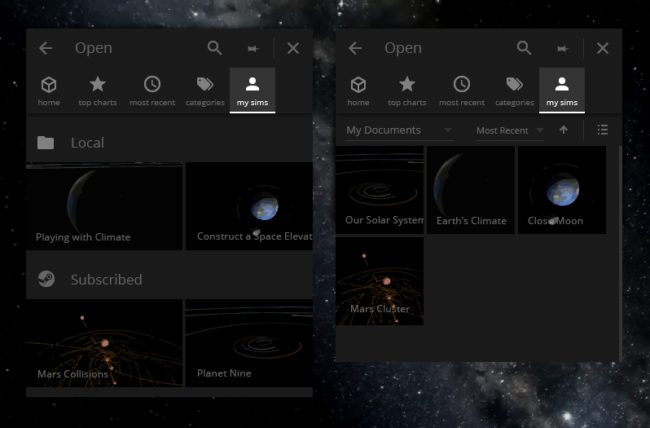
Early design mock-up of a new interface for with support for Steam Workshop simulations.
We’ve just begun work on adding Steam Workshop support to Universe Sandbox ². There’s plenty to do on the design front, and we have kinks to work out with our save & load system, but all things considered, we’re making good progress. Steam Workshop support is often requested by the community, and for good reason — we’re very excited to see what happens once it becomes easy to explore all of the simulations and scenarios the community is creating… and destroying.
- Share Simulations & Objects with the Whole Community
- Space may be a vacuum, but that doesn’t mean you should feel like you’re living in one in Universe Sandbox ². With support for Steam Workshop, you can easily browse, vote on, download, and explore community-created sims and objects, and of course upload your own for the whole community to check out.
- And Eventually, Share Models & Textures Too
- The first iteration will likely only support custom sims and saved objects, but in the future (see below) we plan to add support for custom models and textures as well.
Faster Physics & Performance
Thomas, our physics programmer, has made substantial upgrades to the physics code more times than we can count. But whatever number that is, add one more. We’re extremely grateful for every improvement, as physics is at the core of Universe Sandbox ², and making it faster means a lot more than just simply adding on a few FPS.
- Rewritten Physics Code
- A smoother user experience, more stable simulations at higher time steps, and more room for all of the big, new physics features we’re working toward, such as rigid body collisions, total body fragmentation, and space megastructures.
And Then Into 2018…
Localization
- Supported by New User Interface
- Now that our new user interface is in Universe Sandbox (Update 20), we’re ready to add the localization system.
- Community-Sourced Translations
- We plan to ask you, the community, for help in translating all of the text in Universe Sandbox ². We’re not certain how it will work yet, but our ideal system will let you click on any snippet of text from within Universe Sandbox ² and offer a translation or an improvement on an existing translation.
- Switch On-the-Fly Between Multiple Languages
- You’ll be able to switch at any moment between available translations. What is available depends on the community — as long as one user has offered translations, then it will be available for everyone to use and improve upon.
Custom Models
- Import Models & Textures Created by You or the Community
- This is in some ways the second big part of the Steam Workshop support. Being able to browse and download community-made models and textures which you can use in Universe Sandbox ² is going to help a lot with all of the requests we get for fictional and real spacecraft and planets. Of course, custom models means you can import whatever model you like (limited by file type), so if you’d prefer a cow over a rocket ship, then that’s okay too.
Rigid Body Collisions
- Bouncing and Breaking Apart Human Sized Objects
- Right now, human sized objects in Universe Sandbox ², like dice or bowling balls, will combine when they collide. Rigid body physics will make these collisions much more realistic, so they’ll instead “bounce” off of each other as you would expect them to.
- And Don’t Forget Stacking and Connecting
- Bouncing only makes sense some of the time for rigid body collisions. If you’re on the surface of a planet, for example, then you should also be able to stack these objects. Where does connecting come into this? Well, if you have rocket parts, then those should probably snap together… But we’re still far away from this.
Total Body Fragmentation
- Kaboom!
- With this new system, bodies will completely fragment when the force of a collision is strong enough. This should be most apparent when two equally sized bodies collide, as they should completely fragment apart instead of one “eating” the other, which currently happens.
More Advanced Planet Grids
- More Detailed and Responsive Planet Visuals & Interactions
- The first iteration of Planet Grids which is arriving along with lasers will help with temperature, but eventually the system will become more complex and allow for more advanced simulation, such as freeze heights, improved molten visualization, and…
- ???
- It’s hard to say what Planet Grids has in store for us next. Heat transfer between planetary layers? Life simulation? Maybe! We don’t have an exact plan, but we’re excited by all of the possibilities that open up with Planet Grids.
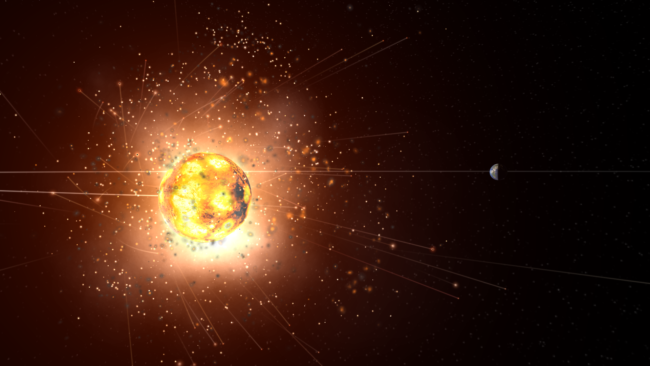
And Into the Distant Future
Mobile Version
- Universe Sandbox ² on Your Phone and Tablet
- Universe Sandbox ² is all about asking fantastical what-if questions. Well, what if you could simulate the universe on your phone? Our guess is you’d probably be pretty happy. At least, that’s what’s been proven true so far whenever we run a test build on our mobile devices. There are many user interface challenges still to solve, but we’re making good progress on this mobile version.
Space Megastructures
- Megastructures, But in Space
- We mention these a lot, even though they’re not on the immediate horizon, because they’re just that exciting to think about. Using physics-based space tethers as the idea behind the basic building block, these structures can come in many pre-defined shapes and sizes, and eventually support building custom structures.
- Think space elevators, Dyson spheres, and ring worlds. And then squeal with joy (and patience).
There isn’t a single item on this list that doesn’t get us excited. We’re happy with how far we’ve already come with Universe Sandbox ², and now we’re itching to see where these new features take us and our fans. There will soon be even more tools for creating and exploring whatever you can imagine, and you’ll have the ability to share these with the entire community, a community that will expand with localization and the mobile version. Many thanks to our ever-growing community of fans for all of your support.
For the latest Universe Sandbox ² news, follow us on Twitter and Facebook.
Total Solar Eclipse | Update 20.1
Aug 14th
August 28: Update 20.1.3 is a small update that adds a number of bug fixes and small improvements.
A solar eclipse occurs when the Moon passes between the Sun and the Earth, and partially or fully blocks the disk of the Sun. When it completely blocks the Sun, it is a total solar eclipse.
Total solar eclipses are rare events, happening about once every 18 months. But the opportunity to view them is even more rare; there is only a very narrow path across Earth from which they can be viewed.
On August 21, 2017, the continental United States will witness its first total solar eclipse in 38 years. Parts of 14 different states, from Lincoln City, Oregon to Charleston, South Carolina, will go dark as the Moon’s shadow passes over them.
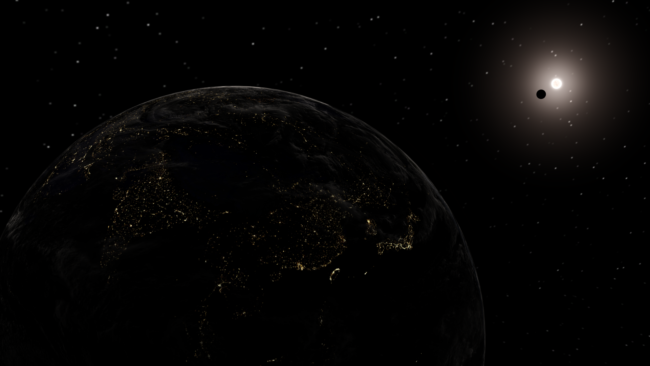
View the solar eclipse in Universe Sandbox ²:
Home > Open > Total Solar Eclipse on August 21, 2017
Home > Open > Total Solar Eclipse on August 21, 2017 – Close Up
Main Menu > August Eclipse (VR)
This update also includes a number of smaller improvements and bug fixes.
Check out the full list of What’s New.
For the latest Universe Sandbox ² news, follow us on Twitter and Facebook.
